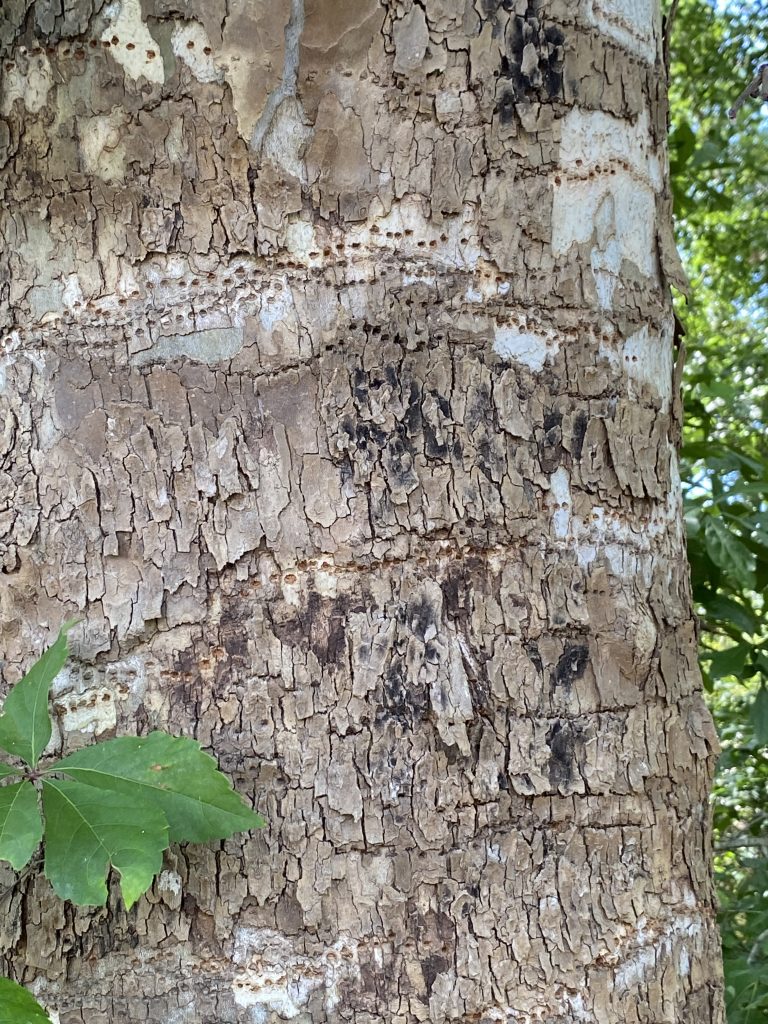They are often very prevalent on trees in our area; a strange string of shallow holes drilled in the bark of a tree. Often this is oozing sap, especially on pines and hardwoods with heavy sap flow, and more holes keep appearing as the sap dries up in others. I get calls and questions all the time about this strange phenomenon and what can be done about it. The calls are usually from homeowners with a prized backyard tree, but I get calls from farmers with orchard crops and other settings as well. What is causing this strange attack on these trees? What drills near perfect holes just into the sapwood of a tree? The answer is a bird of all things; and in particular the yellowbellied sapsucker (Sphyrapicus varius). This small to mid-sized bird is in the woodpecker family and has the peculiar diet of feeding on sweet and nourishing tree sap; as well as small insects attracted to and trapped into the sap. This little native bird drills and taps trees for sweet sap. Much like we humans do with maple trees up north for syrup production. They then visit their trees and drink the sap until the tap dries up and then drill another hole. This pattern of feeding leaves this banding of holes drilled on the tree, and they drill deep enough that it will be visible for quite a long time often permanently.

Yellowbellied Sapsucker damage on an American Sycamore-Walton County, FL Photo Credit: Ian Stone
The biggest question most people want answered, beside what is doing/causing this, is will this hurt the tree? The best answer to that is mostly no, but with all things tree related it depends. On young and smaller trees, particularly newly planted ones, the feeding can stress the tree and can cause some issues. The biggest risk is that if the sapsucker drills in a complete ring around the trunk, something more common on smaller trees, they could cause the tree to be girdled and killed. Another issue is that their feeding can attract pests and disease, such as bark and wood boring beetles along with some fungal infections of the open wounds. These pest and diseases may then go on to cause severe damage and death, especially if the tree is stressed by drought or other environmental factors. Ultimately, the feeding of the yellowbellied sapsucker rarely kills or severely damages trees by itself. Most of the time it just causes unsightly damage, and the bark damage and subsequent healing over can cause an unsightly area of bark. This is especially true on thin barked trees that have smooth bark, such as beech, magnolia, and birch.
You are probably wondering how to prevent this damage in the first place or stop it once a sapsucker takes a liking to your tree. The best thing to do is to make some changes in your landscape to prevent attracting sapsuckers and/or scare them away if they are in the area. Your first step is to learn to identify the yellowbellied sapsucker, so you can tell if they are in the area. Yellowbellied sapsuckers are a woodpecker and to many they look like several of our other small woodpeckers such as the downy, red-cockaded, and possibly even the red bellied. They look the most like a slightly larger downy woodpecker with more red on their heads. Males are the most brightly colored and have a read crown and throat patch, while females have the red crown only. The back and wings are black and white, and have somewhat of a ladder appearance on the back. They are smaller birds, around 7-8 in. in length, similar in size to a robin or cardinal. They cling to the bark and shuffle up and down the tree like other woodpeckers. The namesake yellow belly is faint and difficult to see at a distance without binoculars or other aids

Yellowbellied Sapsucker (Sphyrapicus varius) side profile Photo Credit: Johnny N. Dell, Bugwood.org
If you notice yellowbellied sapsuckers in your area, you can watch them to see which trees they seem attracted to. Once you identify the portion of your yard they seem to like; you can put up windsocks or predatory statues to scare them away. This is the most effective method to keep these somewhat pesky birds out of an area and stop the tree damage. It also does not harm the birds or any other wildlife, though it may scare away birds that you would like to stick around. You may see some information about putting up hardware cloth or metal sheeting around the trunk of the tree. This is not a good method and often it does not stop the sapsuckers, who simply find another unguarded portion of the tree or work around the exclusion device. Using hardware cloth or sheeting can also damage the tree worse than the sapsucker’s feeding activity, and if not properly installed and consistently loosened they can even girdle and kill a tree. If you are having trouble with the interesting but pesky birds, use the scare away method consistently until they leave the area. If they believe predators are in the area and regularly startled while feeding they usually leave for a better feeding area pretty quickly.
- Pro-Tips for Dealing with Problem Oaks and Other Brush in the Home Landscape - November 21, 2024
- Elderberry: A Very Attractive and Useful Native Plant - June 20, 2024
- Pine Bark Beetles – With Warming Weather Comes More Activity - May 9, 2024
